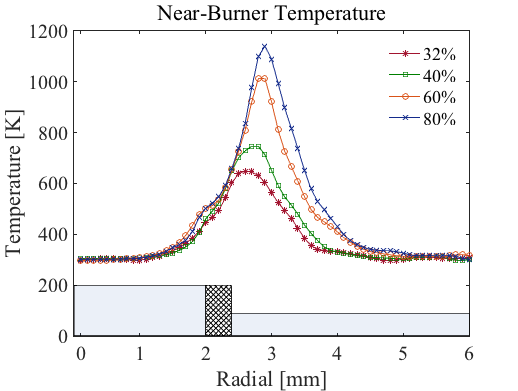Fuel: Ethylene/N2
Oxidizer: Air
Fuel velocity: 35 cm/s (cold-flow velocity)
Oxidizer velocity: 35 cm/s (cold-flow velocity)
Recommended T boundary condition: see BC40.txt below.
Recommended computational domain: At least 8 cm above the fuel tube exit plane and at least 7.5 cm in the radial direction. At least 15,000 non-equispaced control volumes with careful attention paid to grid independence, tolerance independence, and domain length independence.
The data is in a tab delimited, formatted text file, consisting of a two-dimensional array of floating point values. The matrix represents an image with pixel spacing of 0.1 mm (10 pixels/mm). The first element of the matrix corresponds to the value in the upper left corner of the images shown. This type of data can be read in directly to Matlab using the 'load' command.
 |
Soot
Temperature based on color ratio pyrometry using a Nikon D90
camera. Data was published in Ref. 6. Here, soot optical
properties were assumed to be constant throughout the flame
with the emissivity varying with wavelength to the -1.38
power. The data array size is 901 x 201. T40D90.txt |
 |
Soot Volume Fraction based on
color ratio pyrometry using a Nikon D90 camera. Data was
published in Ref. 6. Here, soot optical properties were
assumed to be constant throughout the flame with the
emissivity varying with wavelength to the -1.38 power.
The data array size is 901 x 201. Fv40D90.txt |
 |
Soot Volume
Fraction based on LII and calibrated using absorption. Data
was published in Refs 3-6. Soot optical properties were
assumed to be constant throughout the flame with Kext = 8.6. The data array size is 901 x 201. Fv40LII.txt |
 |
The effective
radius of gyration of mature soot aggregates was measured
using multi-angle light scattering (MALS) at 532 nm. The
experiment was detailed and the data published in Ref. 13.
Only centerline aggregates in the 40% flame were sufficiently
large to be measured with the MALS technique. The data array size is 900 x 200. Rg_eff_40.txt |
 |
40% flame
near-burner temperature. The experiment was detailed and
published in Ref. 14. The data array size is 2 x 60 (r [mm], T [K]). BC40.txt |